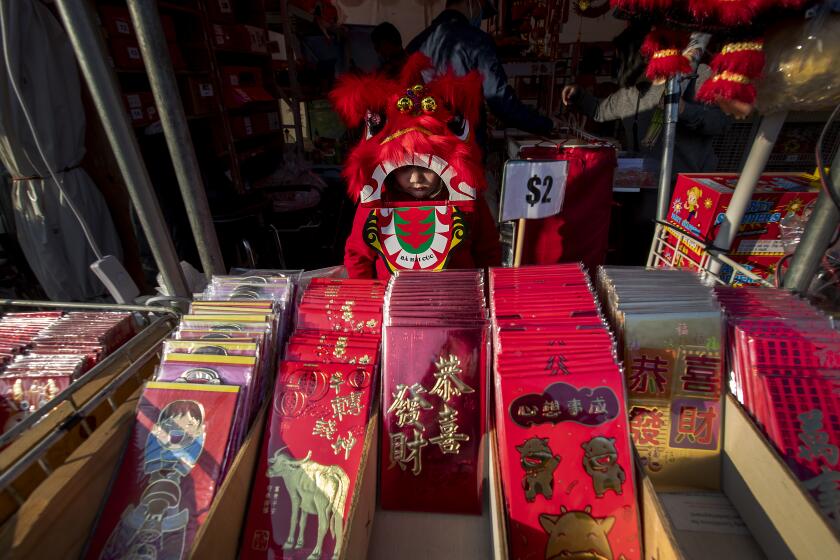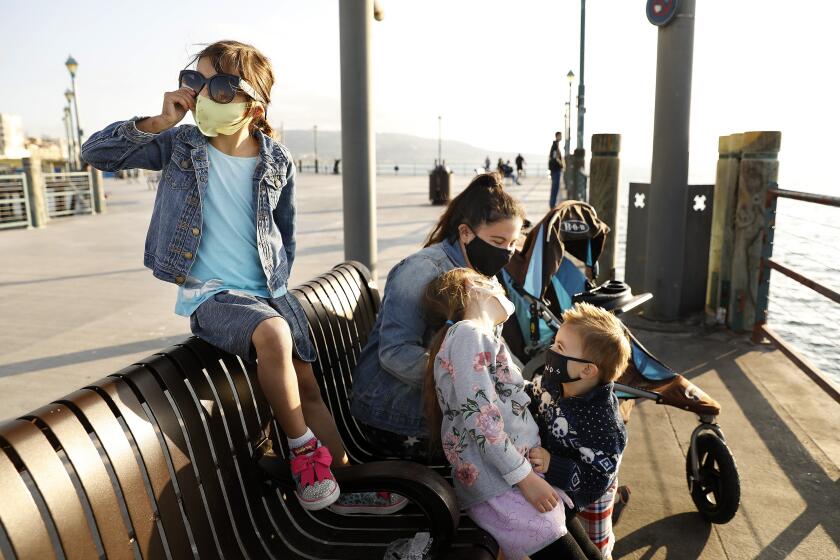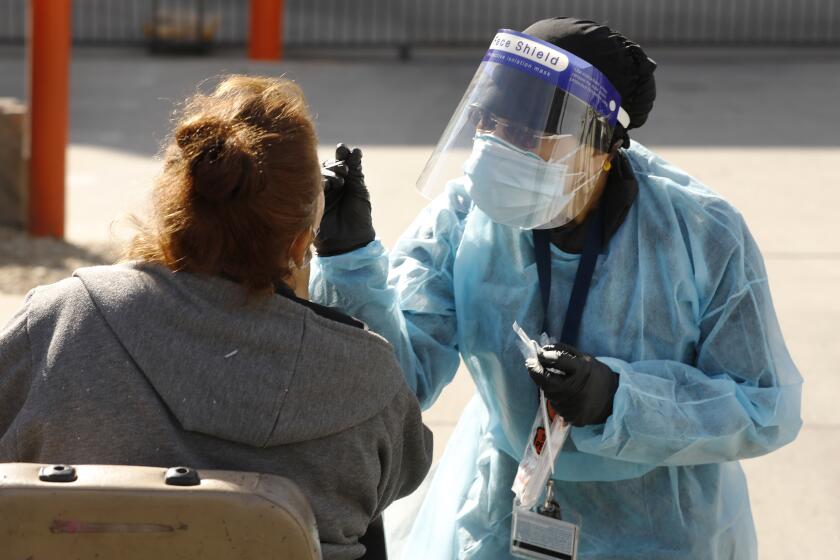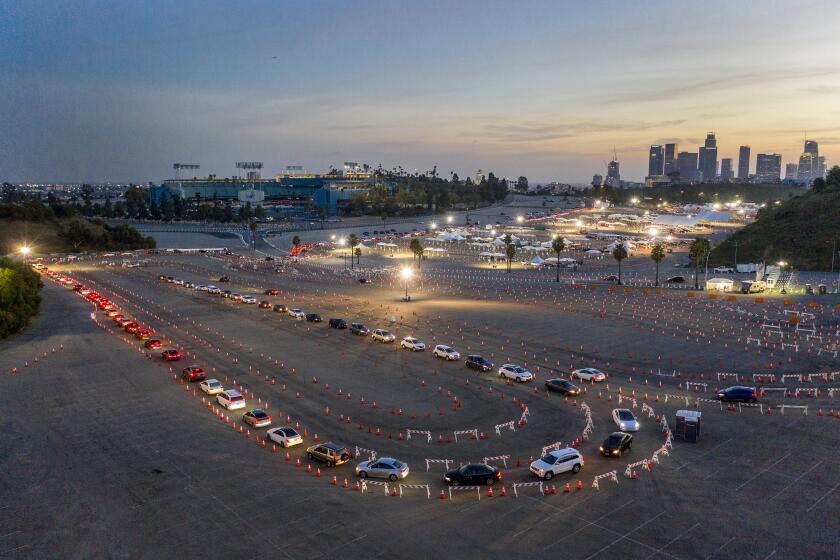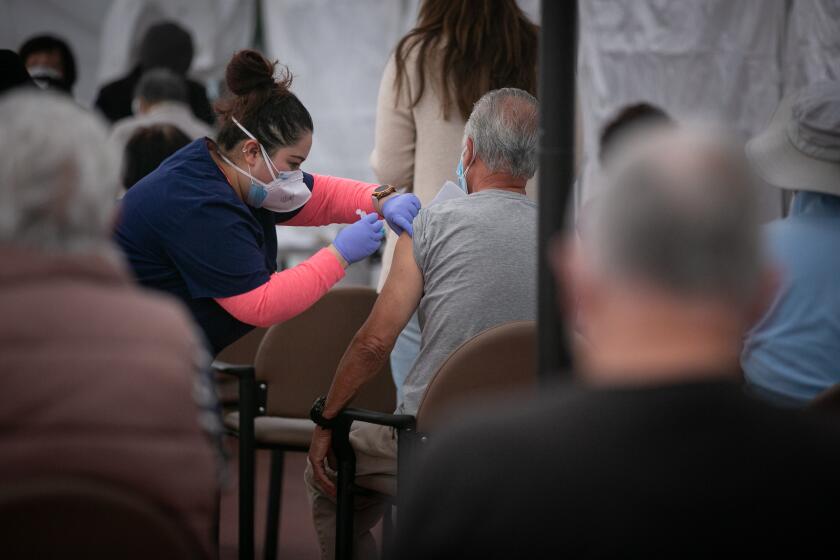California’s COVID-19 surge is receding, but officials still call for holiday caution
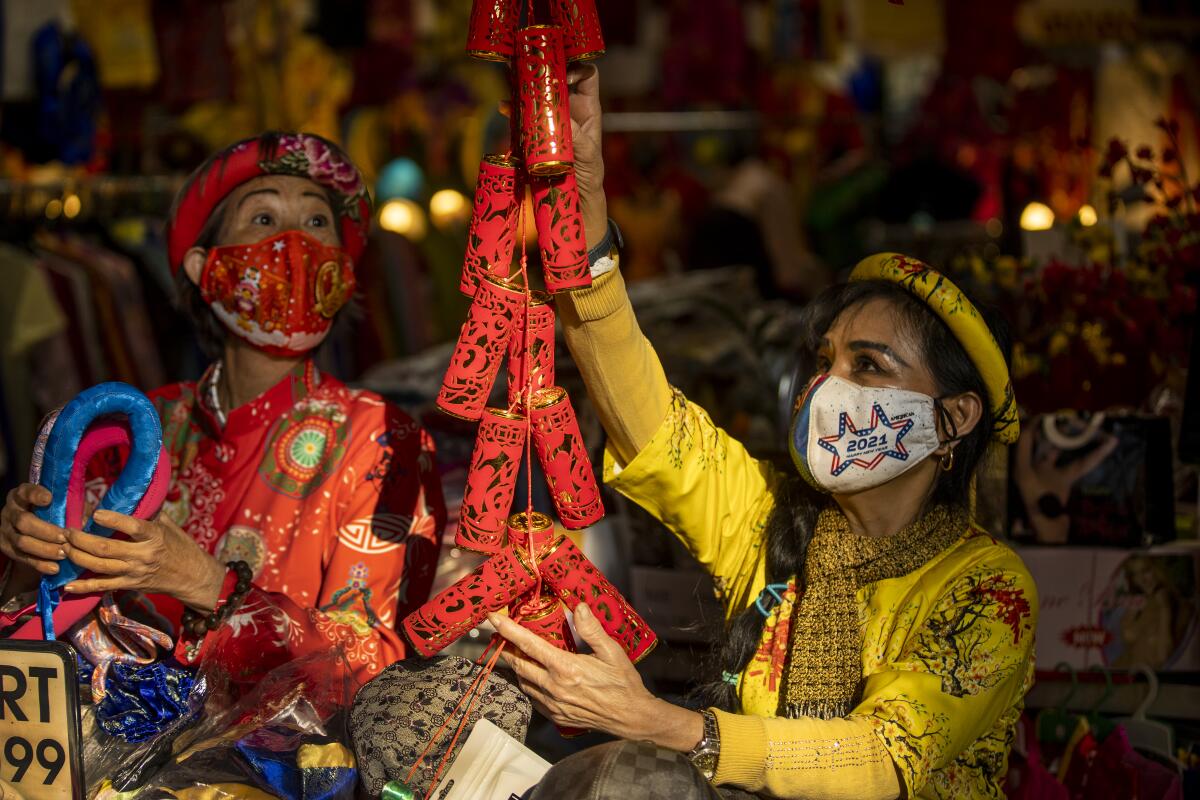
- Share via
California is steadily emerging from the crushing depths of the latest coronavirus surge — prompting optimism that the state is finally heading in the right direction, as well as renewed warnings that this holiday weekend could spur an abrupt about-face if the public lets its guard down.
Officials are particularly urging residents to abstain from crowded or indoor gatherings when they ring in the Lunar New Year or celebrate Valentine’s Day or Presidents Day, saying that such activities still present too great a risk.
“We know from experience that gatherings, parties and the other activities we usually do with nonhousehold members on holidays leads to increases in transmission, hospitalizations and deaths,” Los Angeles County Public Health Director Barbara Ferrer said Thursday. “Continuing to slow transmission requires limiting the number of people we interact with.
“If we do not gather, we save lives.”
Cash in the age of COVID: Asians get creative when it comes to ‘lucky’ lunar money.
Health officials have long preached about the potential pitfalls of attending events with other households — saying that, unless attendees remain cautious and attendance is limited, they can heighten the risk of spreading the coronavirus.
Gatherings around Halloween helped plant the seeds for the state’s autumn-and-winter surge, officials and experts say. Additional mingling and travel over Thanksgiving kicked things into overdrive.
The worst wave of the pandemic crested in early January. At that point, the state was recording nearly 45,000 new coronavirus cases a day.
That figure has tumbled precipitously since then — sinking to an average of 11,180 daily cases as of Thursday, according to data compiled by The Times.
However, that’s still more than three times the average daily caseload California saw before the spike struck.
New cases are but the first link in the coronavirus chain. A portion of those who are infected — state officials have estimated about 12% — will eventually fall ill enough to require hospitalization, and a certain share of those patients will worsen to the point that they need intensive care, and a percentage of those will die.
That means that when new cases rise, so too will the number of people who are hospitalized and ultimately die. When cases fall, those other metrics will follow, usually a few weeks later.
COVID-19 hospitalizations are plunging statewide. On Thursday, there were 9,883 coronavirus-positive patients hospitalized statewide — down 37% from two weeks ago. The last time the hospital census was below 10,000 was Dec. 5, state data show.
Deaths, though still high, have also started to slide from their surge peak. An average of 415 Californians a day have died from COVID-19 over the last week, a 23% decrease from two weeks ago.
New tips from the CDC on how to make your mask more effective to protect against the spread of the coronavirus focus on a better fit.
Given this correlation between cases, hospitalizations and deaths, officials emphasize that the only way to avoid additional suffering down the line is to continue to tamp down transmission of the virus.
“The cases are coming down, but they still remain high,” said L.A. County Health Officer Dr. Muntu Davis. “And so people need to understand that, even though they’re coming down, the risk of running into someone with COVID-19 who may not know it is still very high.”
While that’s been the case throughout the pandemic, a wild card now is the presence of new and highly contagious coronavirus variants.
Experts have noted that the emergence of those variants isn’t unexpected, as each new infection gives the virus a chance to mutate as it replicates. Many of these mutations may not functionally alter how the virus behaves, but in some cases they can affect how easily the virus spreads, or how sick it makes those it infects.
Coronavirus variant first seen in L.A. now accounts for about half of Southern California’s infections and has spread to 18 states and six countries.
A particularly concerning example is the variant known as B.1.1.7, which was first identified in Britain and is believed to be 50% more transmissible than the more common strain.
That variant has been found in 981 people in 37 U.S. states so far, according to the Centers for Disease Control and Prevention. California has documented 159 cases so far, including in Alameda, Los Angeles, Orange, Riverside, San Bernardino, San Diego, San Mateo and Yolo counties, according to the state Department of Public Health.
“With increased reports of the U.K. variant circulating in L.A. County and around the country, it is likely much easier for COVID-19 to spread during activities where people aren’t protected,” Ferrer said during a briefing this week. “So, once again, the only way for us to continue to slow transmission is if everyone chooses safety this upcoming weekend.”
Another coronavirus variant, first identified in South Africa, has been identified in two people in the Bay Area, Gov. Gavin Newsom said this week.
California also is seeing a rise in the number of cases associated with a homegrown coronavirus strain.
First seen in Los Angeles in July, that variant now accounts for about 44% of new infections in Southern California and more than a third of new infections throughout the state, and has spread across the U.S. and to six other countries, according to the study in the Journal of the American Medical Assn.
Five L.A.-run sites exhausted their supplies Thursday, city officials said. They’ll reopen when the city receives more vaccines, Mayor Eric Garcetti says.
The rise of new variants lends additional urgency to the rollout of COVID-19 vaccines.
Officials say those efforts are being slowed, however, by a shortage of supply. Some parts of California have had to hold off on vaccinating certain eligible groups in the face of insufficient shipments, while others have had to cut back on how many people receive a first dose to ensure there are enough shots available to give people their required second dose.
In Los Angeles, some vaccination sites that were already slated to close Friday due to supply shortages ran out of doses sooner than expected and had to start turning people away Thursday.
Of the 219,700 doses that arrived this week, more than half will be needed to provide second shots, according to Dr. Paul Simon, chief science officer for the L.A. County Department of Public Health.
“That is simply to fulfill our commitment to make sure that everyone that received first doses three to four weeks ago will get a second dose,” he said during a briefing Friday. “But there will be a large number of doses available as first doses. It will be less than 50%, but still a significant number.”
The priority for what first doses are available, he added, will be communities that have been hardest hit by the pandemic “to make sure that we’re reaching those at greatest risk.”
Health officials throughout the state say that their capacity to dole out vaccines far outstrips the number of doses that are available at this point. In L.A. County, for instance, Simon said providers could likely administer up to 600,000 doses a week if they had the supply.
“We’re all frustrated,” he said. “We know we could do much more if we had available doses.”
People with cancer, obesity and certain other conditions will be eligible for vaccinations starting March 15.
So far, about 8.1 million vaccine doses have been delivered throughout California, and nearly 5.3 million have been administered, according to data compiled by The Times.
There is hope that an influx of inoculations is on the way. President Biden announced Thursday that his administration has secured a total of 600 million doses, split evenly between Pfizer and Moderna, to be delivered by the end of July. That would be enough to fully vaccinate the roughly 260 million people eligible for the shots nationwide.
“We can’t move fast enough,” Newsom said earlier this week. “We’re sober; we’re mindful of the scarcity that is the number of available vaccines in the United States of America. Nonetheless, we are not naive about our responsibility here in the state of California to move these vaccines out of the freezers and into people’s arms.”
Times staff writers Hayley Smith, Maya Lau and Melissa Healy contributed to this report.
More to Read
Sign up for Essential California
The most important California stories and recommendations in your inbox every morning.
You may occasionally receive promotional content from the Los Angeles Times.
